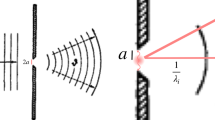Abstract
The extended semantic realism (ESR) model proposes a theoretical perspective which reinterprets quantum probabilities as conditional on detection rather than absolute and embodies the mathematical formalism of standard (Hilbert space) quantum mechanics (QM) in a noncontextual, hence local, framework. The assumptions needed to prove the Bell inequality therefore hold in the ESR model, but we show that the Bell inequality must be substituted in it by the modified Bell inequality and that the standard quantum expectation values, when reinterpreted as proposed by the ESR model, do not violate the latter inequality. Hence the long-standing conflict between “local realism” and QM is settled in the ESR model. Finally we provide an elementary example of a prediction that might be used to check whether the ESR model is correct.
Similar content being viewed by others
References
Garola, C., Sozzo, S.: Embedding quantum mechanics into a broader noncontextual theory: a conciliatory result. Int. J. Theor. Phys. 49, 3101–3117 (2010)
Garola, C., Sozzo, S.: Generalized observables, Bell’s inequalities and mixtures in the ESR model for QM. Found. Phys. 41, 424–449 (2011)
Busch, P., Lahti, P.J., Mittelstaedt, P.: The Quantum Theory of Measurement. Springer, Berlin (1991)
Bell, J.S.: On the problem of hidden variables in quantum mechanics. Rev. Mod. Phys. 38, 447–452 (1966)
Kochen, S., Specker, E.P.: The problem of hidden variables in quantum mechanics. J. Math. Mech. 17, 59–87 (1967)
Bell, J.S.: On the Einstein-Podolsky-Rosen paradox. Physics 1, 195–200 (1964)
Garola, C., Solombrino, L.: The theoretical apparatus of semantic realism: a new language for classical and quantum physics. Found. Phys. 26, 1121–1164 (1996)
Garola, C.: Essay review: waves, information, and foundations of physics. Stud. Hist. Philos. Mod. Phys. 33, 101–116 (2002)
Garola, C., Pykacz, J.: Locality and measurements within the SR model for an objective interpretation of quantum mechanics. Found. Phys. 34, 449–475 (2004)
Garola, C.: MGP versus Kochen-Specker condition in hidden variables theories. Int. J. Theor. Phys. 44, 807–814 (2005)
Garola, C., Sozzo, S.: Realistic aspects in the standard interpretation of quantum mechanics. Humana.Mente, J. Philos. Stud. 13, 81–101 (2010)
Garola, C., Solombrino, L.: Semantic realism versus EPR-like paradoxes: the Furry, Bohm-Aharonov, and Bell paradoxes. Found. Phys. 26, 1329–1356 (1996)
Garola, C.: Objectivity versus nonobjectivity in quantum mechanics. Found. Phys. 30, 1539–1565 (2000)
Garola, C.: A simple model for an objective interpretation of quantum mechanics. Found. Phys. 32, 1597–1615 (2002)
Garola, C.: Embedding quantum mechanics into an objective framework. Found. Phys. Lett. 16, 605–612 (2003)
Garola, C., Sozzo, S.: The ESR model: a proposal for a noncontextual and local Hilbert space extension of QM. Europhys. Lett. 86, 20009 (2009)
Sozzo, S., Garola, C.: A Hilbert space representation of generalized observables and measurement processes in the ESR model. Int. J. Theor. Phys. (2010). doi:10.1007/s10773-010-0264-y
Clauser, J.F., Horne, M.A., Shimony, A., Holt, R.A.: Proposed experiment to test local hidden-variable theories. Phys. Rev. Lett. 23, 880–884 (1969)
Beltrametti, E.G., Cassinelli, G.: The Logic of Quantum Mechanics. Addison-Wesley, Reading (1981)
Norsen, T.: Against ‘realism’. Found. Phys. 37, 311–340 (2007)
Aspect, A., Dalibard, J., Rogers, G.: Experimental test of Bell’s inequalities using time-varying analyzers. Phys. Rev. Lett. 49, 1804–1807 (1982)
Kwiat, P.G., Steinberg, A.M., Chiao, R.Y.: High-visibility interference in a Bell-inequality experiment for energy and time. Phys. Rev. A 47, R2472–R2475 (1993)
Aspect, A., Grangier, P.: Experimental tests of Bell’s inequalities. In: Beltrametti, E.G., Lévy-Leblond, J.M. (eds.) Advances in Quantum Phenomena, pp. 201–214. Plenum Press, New York (1995)
Rowe, M.A., Kielpinski, D., Meyer, V., Sackett, C.A., Itano, W.M., Monroe, C., Wineland, D.J.: Experimental violation of a Bell’s inequality with efficient detection. Nature 409, 791–794 (2001)
Fine, A.: Hidden variables, joint probability and the Bell inequalities. Phys. Rev. Lett. 48, 291–295 (1982)
Fine, A.: Correlations and efficiency: testing the Bell inequalities. Found. Phys. 19, 453–478 (1989)
De Caro, L., Garuccio, A.: Bell’s inequality, trichotomic observables, and supplementary assumptions. Phys. Rev. A 54, 174–181 (1996)
Gisin, N., Gisin, B.: A local hidden variable model of quantum correlation exploiting the detection loophole. Phys. Lett. A 260, 323–327 (1999)
Szabo, L.E.: On Fine’s resolution of the EPR-Bell problem. Found. Phys. 30, 1891–1909 (2000)
Szabo, L.E., Fine, A.: A local hidden variable theory for the GHZ experiment. Phys. Lett. A 295, 229–240 (2002)
Santos, E.: The failure to perform a loophole-free test of Bell’s inequality supports local realism. Found. Phys. 34, 1643–1673 (2004)
Santos, E.: Bell’s theorem and the experiments: increasing empirical support for local realism? Stud. Hist. Philos. Mod. Phys. 36, 544–565 (2005)
Adenier, G., Khrennikov, A.Y.: Is the fair sampling assumption supported by the EPR experiments? J. Phys. B 42, 131–141 (2007)
Adenier, G.: Violation of Bell inequalities as a violation of fair sampling in threshold detectors. In: Accardi, L., et al. (ed.) Foundations of Probability and Physics, vol. 5, pp. 8–17. American Institute of Physics, Melville (2009)
Adenier, G., Basieva, I., Khrennikov, A.Y., Watanabe, N.: Violation of Bell inequalities with a mixture of separable states in a multiple-photon absorption attack on Ekert protocol (2010). arXiv:1011.4740v1 [quant-ph]
Author information
Authors and Affiliations
Corresponding author
Rights and permissions
About this article
Cite this article
Garola, C., Sozzo, S. The Modified Bell Inequality and Its Physical Implications in the ESR Model. Int J Theor Phys 50, 3787–3799 (2011). https://doi.org/10.1007/s10773-011-0743-9
Received:
Accepted:
Published:
Issue Date:
DOI: https://doi.org/10.1007/s10773-011-0743-9




